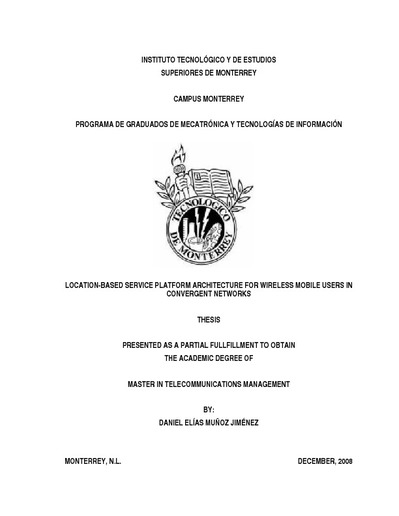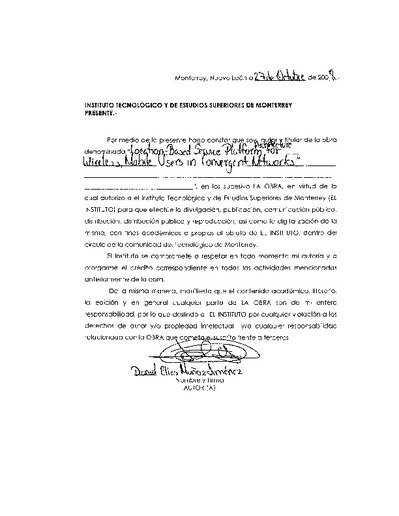| dc.contributor.advisor | Muñoz Rodríguez, David | |
| dc.contributor.author | Muñoz Jiménez, Daniel Elías | |
| dc.creator | MUÑOZ JIMÉNEZ, DANIEL ELÍAS; 219334 | es_MX |
| dc.date.accessioned | 2015-08-17T10:09:41Z | en |
| dc.date.available | 2015-08-17T10:09:41Z | en |
| dc.date.issued | 2008-12-01 | |
| dc.identifier.uri | http://hdl.handle.net/11285/568895 | en |
| dc.description.abstract | Current communications are not only by voice but also carriers are capable to use their
networks to transmit data and video, resources that customers are using more and integrating
phenomenally fast to their daily lives. Wireless companies have a trouble in their hands, competition
and technologies are cheaper than what they were in the 90’s, so, increasing fees are not on the
table for discussion. Then, they have to offer other services without impacting their customers,
attracting them and add value to their networks.
Current cellular customers demand new features delivered by their cellular companies.
Different services have been deployed over the years to satisfy customer’s needs, such as SMS,
mobile Internet, mobile tv, etc. Other kinds of services that have appeared on the market are those
named as LBS (Location-Based Services). LBS are beginning to show that they may increase the
value perceived by customers when they choose a company. Moreover, they are deployed to satisfy
existent requirements and capable to be personalized according to user preferences through
applications contained in mobile devices. These services are based on positioning information
gathered by mobile networks and delivered to service providers, the owners of technological
platforms in charge to process data and requests and deliver value-added information in return.
The increasing LBS market has been aided by the use of the Internet Protocol (IP) and the
development of application protocols such as SMPP, SUPL and MLP. These protocols are beginning
to be used not only inside the carriers’ core networks but also on users’ mobile terminals, increasing
not only market penetration but also the development of different content. Furthermore, we can
mention that IP is merely an ally and not the final solution for the LBS platform in our case.
Mobile providers in some cases prefer to become merely carriers and establish agreements
with service providers instead of deploying these services in home and invest capital that they are not
willing to spend either. Nevertheless, carriers have the advantage to be able to add to their network a
wide variety of services because they can get agreements with many services providers. This is also
possible thanks to the compatibility of certain technologies and protocols existing in the market.
This work shows a platform developed to attend different requests from different networks,
accepting interfaces as SMS, WAP and HTTP. The general concept proposed considers storing
information and flow control over the service provisioning, different characteristics to others proposed
by other authors. This work’s main characteristics are inner flow control and profiling done by an
entity named Central Control Unit (CCU) helping storing useful data considered for further service
provisioning managed and controlled by a server named MCS (Management and Control Server).
The MCS is also defined for gathering information gotten from the carriers’ databases. This
information is accessed by the SEE (Service Execution Environment) using clients defined to request
the necessary information managed by the MCS and be used by the SEE to deliver value-added
information results to mobile users. | |
| dc.language | eng | |
| dc.publisher | Instituto Tecnológico y de Estudios Superiores de Monterrey | |
| dc.relation | Investigadores | es_MX |
| dc.relation | Estudiantes | es_MX |
| dc.relation.isFormatOf | versión publicada | es_MX |
| dc.relation.isreferencedby | REPOSITORIO NACIONAL CONACYT | |
| dc.rights | openAccess | |
| dc.rights.uri | http://creativecommons.org/licenses/by-nc-nd/4.0 | * |
| dc.subject.classification | 7 INGENIERÍA Y TECNOLOGÍA | es_MX |
| dc.subject.classification | Area::INGENIERÍA Y TECNOLOGÍA::CIENCIAS TECNOLÓGICAS::TECNOLOGÍA DE LAS TELECOMUNICACIONES | es_MX |
| dc.title | Location-based service platform architecture for wireless mobile users in convergent networks | |
| dc.type | Tesis de Maestría / master Thesis | |
| dc.contributor.department | ITESM-Campus Monterrey | en |
| refterms.dateFOA | 2018-03-23T17:21:35Z | |
| refterms.dateFOA | 2018-03-23T17:21:35Z | |
| dc.identificator | 7 | |
| dc.identificator | 33 | |
| dc.identificator | 3325 | |



